SCP Ventures The State of the Arweave Ecosystem After Arweave 2.6
SCP Ventures' report on the Arweave ecosystem post Arweave 2.6.Author: Spike
Since its establishment, Arweave SCP Ventures has set its goal to promote the widespread adoption of Arweave. Since the upgrade to Arweave 2.6, the ecosystem of Arweave has entered a small period of prosperity. In order to fully demonstrate this progress, SCP Ventures, together with Forward Research and everVision, has jointly written this report for readers to enjoy.
Key Insight
- Formal Verification – The Ultimate Solution for Contract Security
- Long Push Receiving 1 million ARB airdrop, Summary and Reflections on 2 Years in the Circle
- Singapore VS Hong Kong, TOKEN2049 ignites the battle of the twin cities of Web3!
Arweave enters the period of data explosion. The network size of Arweave has exceeded 100 PB, the number of mainnet transactions has reached 1 billion, the number of Bundlr transactions has exceeded 100 million, the number of everLianGuaiy transactions has exceeded 10 million, and the number of developers has grown by 933% in 3 years.
The upgrade to Arweave 2.6 marks a new change in underlying innovation. Mechanical hard drives can participate in mainnet mining, and the value weight of rare data will be increased;
The foundation of the creator’s economy is already complete. UDL (Universal Data License), UCM (Universal Content Marketplace), and the combination of $U will change the face of the creator’s economy in the next era.
The construction of Arweave’s ecosystem is steadily progressing in the bear market. The number of projects within the ecosystem has exceeded 130, expanding from development tools to various fields such as DeFi, NFT, DDB, storage, RWA, content, and DePIN. Arweave’s ecosystem projects are well prepared for the next bull market.
Developers will have more development tools. Currently, Arweave has a total of 62 developers active in the open source community, with Forward Research, everVision, and Community Labs being the main forces. EverID and Permaswap have made sufficient preparations for mass adoption, and achieving a user base of 1 billion is the next goal for Arweave.
With the help of SCP theory, Arweave has transitioned from cold storage to hot computing, from static to dynamic. The significant performance improvement brought by separating storage and computing will allow developers to fully meet users’ arbitrary needs, eliminating the performance limitations of public chains and the user’s usage threshold.
LianGuairt I: Introduction to Arweave
Unlike the storage public chains we are familiar with, Arweave has unlimited scalability and the ability to connect to any public chain, DeFi, NFT, and other applications. Generally speaking, Arweave is currently one of the mainstream Layer 1 public chains that still adhere to the PoW mechanism and decentralized operation.
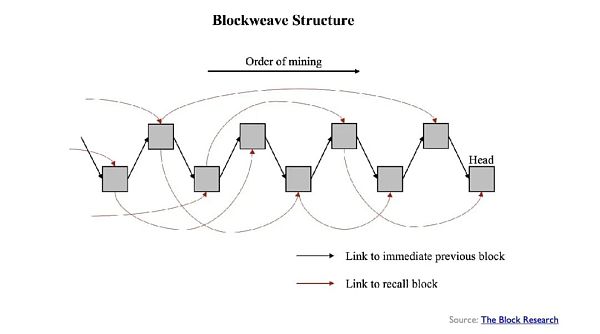
Image description: Blockweave Structure, Image source: The Block Research
SCP Ventures will briefly review the uniqueness of Arweave. The following mechanisms constitute the main technical components of Arweave:
SPoRA (Succinct Proof of Random Access), in the process of participating in Arweave mining, storage service providers not only need to access common predecessor blocks and successor blocks, but also need to access randomly recalled blocks to ensure multiple backups of network data. Under the current mechanism design, any data is saved in at least nearly 1,000 copies.
-
SmartWeave is the smart contract of Arweave. Unlike Ethereum’s “off-chain storage + on-chain computation” mechanism, Arweave adopts the design concept of Lazy Evaluation, which can be understood as the reverse of Ethereum – “off-chain computation + off-chain storage”. Therefore, Arweave has the strongest data availability and unlimited scalability among current public chains.
-
Permanent storage. Arweave does not have an inflation mechanism. When users pay storage fees using $AR, a portion of the funds will enter the Endowment, which adopts a linear release mechanism to subsidize storage service providers. Therefore, data on Arweave can be stored for at least 200 years.
-
Permaweb. Arweave’s use cases go beyond static storage and can support the construction of dynamic applications. From top to bottom, Permaweb has a three-layer architecture consisting of the application layer, service layer, and storage layer. It has backend permanent storage and immutability, while users can overwrite it on the frontend to support complex business requirements.
In general, Arweave’s architecture is oriented towards permanent storage, but it is not simply a personal cloud storage or static database. It is a network infrastructure that can support large-scale use by people. It will take a long time for users to recognize this fundamental difference.
However, regardless of that, the ecological construction of Arweave has already begun, and SCP Ventures will also introduce its components and ecological progress in detail in the following sections of this report.
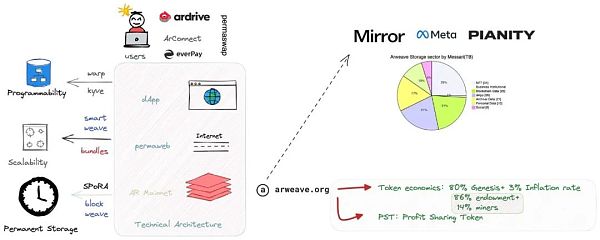
Image Description: Arweave Structure, Image Source: Arweave SCP Ventures
LianGuaiRT II: New Progress since Arweave 2.6
Arweave 2.6, activated since March, has changed the operating principles of Arweave from multiple aspects, but always centered around the initial goal of “pay once, store permanently”. The most important innovations include three points.
Arweave 2.6 will introduce a dynamic pricing mechanism. The protocol will specify the maximum speed of hard drives, allowing for a calculable calculation of hard drive prices. In this mechanism, storage service providers using hard drives that exceed the specified speed will not receive additional rewards;

Image Description: Dynamic Pricing Mechanism, Image Source: Arweave SCP Ventures
Therefore, storage service providers using cheaper mechanical hard drives (HDDs) will become more profitable. According to calculations, based on the current average hard drive Mean Time Between Failures (MTBF), if the Arweave mainnet wants to guarantee storage efficiency for at least 200 years, each piece of data needs at least 15 copies;
Ultimately, Arweave hopes to incentivize storage service providers to store more data, especially rare data backups and data types with heavy space requirements such as audio and video. Specifically, after the update, Arweave will add a new data partition (LianGuairtitions), which will be organized in a scale of 3.6 TB to improve the scale effect of data utilization.
Since the upgrade, the network scale of Arweave has successfully exceeded 100 PB in the past six months, and the total number of transactions has exceeded 1 billion. Currently, the average number of file copies is around 1,000.
All of this is not only due to the Arweave 2.6 update, but also the contribution of the Bundle standard based on the ANS-104 standard. Simply put, Bundle is a Layer 2 standard on Arweave, which packages more data together and submits it to the mainnet to improve the efficiency of data uploads. The main tools currently used are Arseeding and Bundlr, which are open-sourced by Web3Infra.
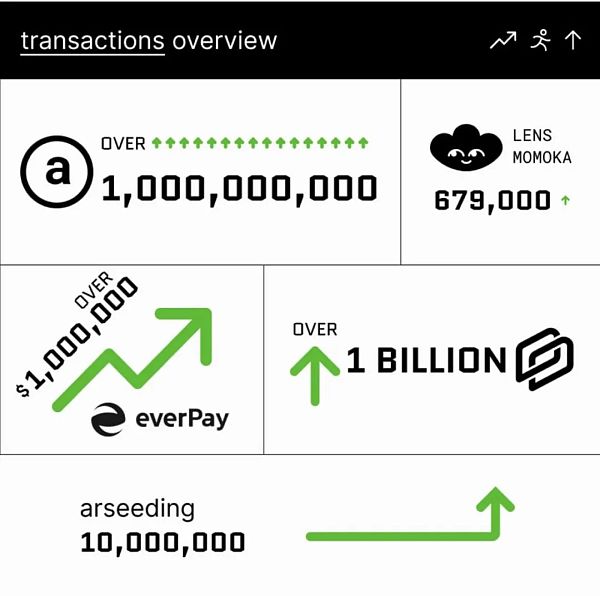
Image description: Arweave Eco Stats Image source: Arweave SCP Ventures
DeFi and basic development tools are the main driving forces behind the growth of Arweave’s data.
Bundlr and Lens Protocol have reached a deep cooperation. As a blockchain data storage solution, Bundlr reduces the transaction fee to only $0.0003 per transaction. It has achieved 679,000 on-chain transactions with a total value of $214. Moreover, the total data adoption of Bundlr has exceeded 100 million, which is another milestone for the entire Arweave ecosystem.
In addition, Arseeding also exceeded 10 million transactions at the end of August, mainly driven by DeFi transactions led by everLianGuaiy, and has been extended to more service hosting services, such as the large-scale adoption by 4everLand.
Furthermore, more underlying infrastructure is being developed. The most important ones are the adoption of UDL, UCM, and $U protocols designed by Forward Research. The three will change the current situation of simple data uploads from the basic protocol layer and stimulate more economic value.
UDL (Universal Data License) aims to give creators more autonomy. Creators can set the length of the license period, the type of currency and fees for payment, etc., and can directly use Bundlr to synchronize the settings when uploading, and the assets will be available on the Permaweb afterwards.
UCM (Universal Content Marketplace), after the content marked with UDL is uploaded, it becomes an atomic asset type on the Permaweb, and the divisibility and tradability brought by smart contracts make any format of content have trading value, including text, images, streaming media, and even tokens and NFTs. This will fundamentally innovate the existing content creator economy.
$U, when users pay for storage fees, is minted at a 1:1 ratio from AR that enters the Endowment. It can be directly traded on Permaswap or obtained when using Arseeding or Bundlr to upload, in order to support more creators in monetizing their content.
In addition, important basic protocols are also making progress. For example, the Universal Commenting Protocol (UCP) allows users to interact with content on Arweave and sign with their wallets to verify their authorship. UCP allows permanent storage of comments, preventing arbitrary censorship or deletion, giving users the freedom to express their thoughts, communicate, and cultivate a strong community.
In order to illustrate the specific use cases of these innovations, Forward Research has created a super demo product called BazAR NFT Marketplace. It supports the use of UDL and UCM, allowing NFTs to circulate and trade within the atomic asset category, and can be purchased using $U.
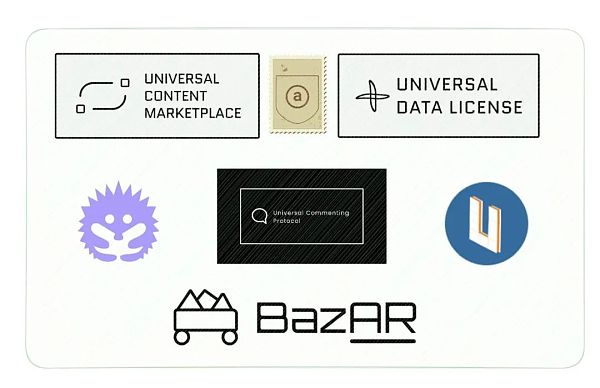
Image description: BazAR NFT Marketplace Tech Structure. Image source: Arweave SCP Ventures
The underlying infrastructure of Arweave is already rich enough. What is needed next is more application development and data usage. In order to explain the current data growth situation in detail, SCP Ventures will interpret the network data since the Arweave 2.6 update.
LianGuairt III: Data Interpretation
Description: Due to limitations in the research method, the data source is viewblock.io, and the statistical time period is from March 2023 to August 2023, which is sufficient to illustrate the current network status of Arweave over a six-month period.
Starting with the most basic storage cost, the storage price of Arweave is dynamic. However, this is not the whole truth. According to the fluctuation of AR’s price, currently (September 2023), the price of storing 1 TB on Arweave is about $3500, but we need to note that this is the cost of permanent storage.
In fact, according to the calculation by CoinGecko in May, based on the price of storing 1 TB per month, Arweave only requires about $2.13, which is only 10% of Amazon S3 and can be stored for more than 200 years.
In terms of storage scale, the data scale of Arweave has entered a steady growth stage. SCP Ventures has collected detailed data from March to August to explain the data explosion of Arweave.
Since March, the Arweave mainnet has maintained a high-frequency growth stage of around 100 million transactions per month. Both July and August exceeded 100 million transactions in a single month. With this data driving force, the number of transactions in Q2 2023 (April/May/June) exceeded 260 million, and it is expected that Q3 will exceed 300 million given the current growth trend.
Although the price of AR has decreased compared to the peak of the bull market, the trading and usage of AR are still growing rapidly. For example, stimulated by the upgrade in March, the monthly trading volume reached 17 million AR, with an average of about 10 million (9,158,368) per month. The trading volume in March, June, and August exceeded 10 million, and the trading volume began to rise in July and August, indicating further growth to come.
With the continuous boost of data, the network scale of Arweave has remained above 125 TB since March and has been steadily increasing at a rate of 2 TB per month for 6 months. In the bear market environment, these data are undoubtedly more real and valuable. By the end of this year, the weave size of Arweave may approach 150 TB.
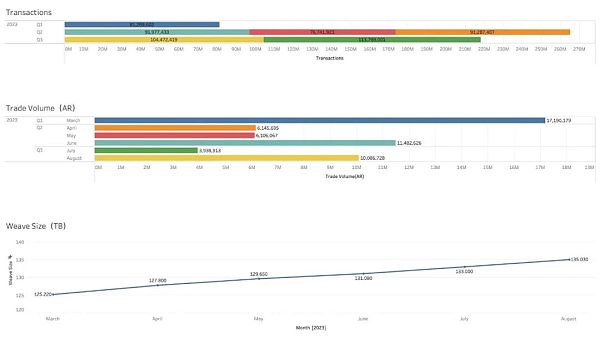
Image description: Arweave tx/trade volume/Weave Size Stats. Image source: Arweave SCP Ventures
After reviewing the data growth situation, the on-chain address data of Arweave is also worth paying attention to. Since March, the growth of contract addresses on Arweave has exploded, especially in April of Q2, with a monthly growth of nearly 2 million (1,919,789), and the overall data growth exceeded 4 million for that quarter.
As a result of this data, the number of active addresses on the Arweave chain has also started to grow rapidly, skyrocketing from 479 in March to 1,042 in June. This marks the first time Arweave has surpassed 1,000 active addresses.
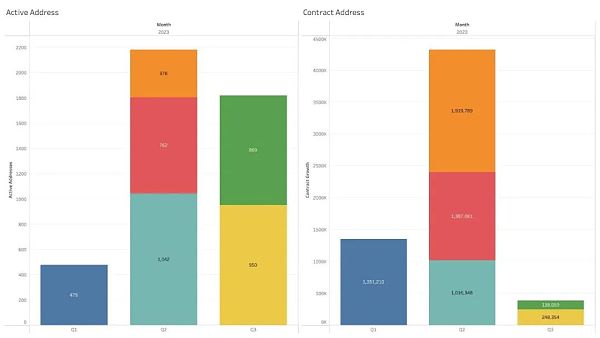
Image description: Arweave Address Stats. Image source: Arweave SCP Ventures.
Overall, Arweave’s data growth has continued to increase even during the bear market. This can be attributed to Arweave’s transformative measures and the flourishing of its ecosystem projects. From a macro perspective, Arweave’s data growth mainly relies on storage dApp applications. However, there are also new trends worth noting, such as DDB (decentralized databases) and network hosting services. Together, they will form the main driving force for Arweave’s future data growth.
Arweave has also not stopped exploring in broader areas of the native crypto field, such as DeFi and NFT. Among them, the most notable are the creator economy, abstract accounts, and DeFi practices guided by SCP theory.
LianGuairt IV: Key Progress of Arweave Eco
According to statistics from Community Labs, by the end of 2022, most projects within the Arweave ecosystem were development tools. However, by 2023, most applications have transitioned into application-based ones.
The construction of the infrastructure for Arweave’s ecosystem has been largely completed and is gradually transitioning to ecosystem development and market expansion.
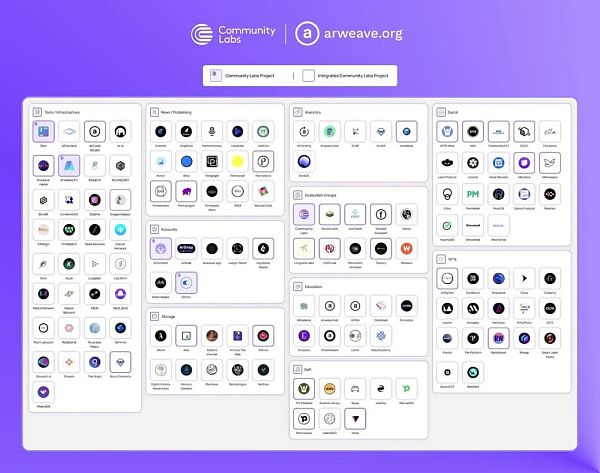
Image description: Arweave Eco. Image source: Community Labs.
For example, DDB (decentralized databases) is an area with potential for growth and exploration. Currently, various database services have been built on Arweave, including SQL and NoSQL types. In terms of operational mode, they largely follow a dual architecture where Arweave serves as the data storage layer and Incentive Network handles operations. Among them, Mind Network aims to build a ZK + FHE data encryption layer, while Kwil and WeaveDB are typical representatives of SQL and NoSQL, respectively. Kwil provides high-performance services similar to MySQL, while WeaveDB aims to provide a multi-file database similar to MongoDB to support the use of non-numeric data such as files, audio, and video.
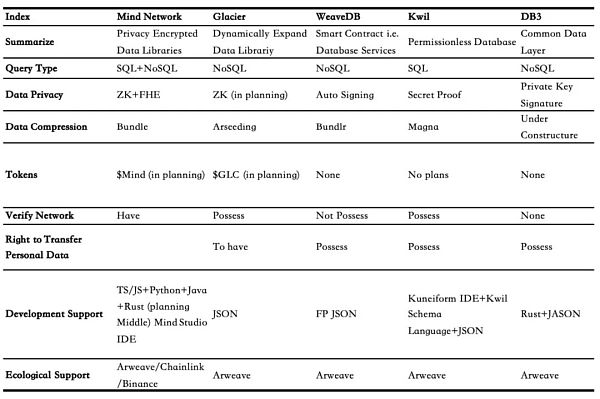
Overall, the current use cases of Arweave still mainly focus on storage services, while DDB represents a new direction for application development. These stacks will greatly enhance developers’ efficiency on Arweave.
LianGuairt V: Dev Tool & Developer Stats
According to statistics, Arweave currently has 17 full-time developers, and with part-time developers, the number of monthly active developers is around 62. As a trend, the activity and number of developers in open-source code repositories have been increasing year by year, especially since 2023.
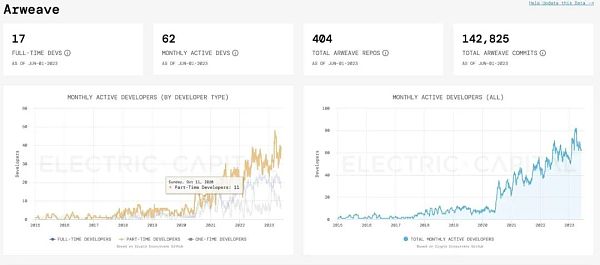
Image description: Arweave developer data. Image source: developerreport.com/ecosystems/arweave.
From a developer’s perspective, Arweave can be understood as a backend framework or a public database, so it particularly needs two types of services, gateways and index building tools.
In terms of gateway design, the previously mentioned Arseeding and Bundlr can both be understood as light nodes, which also provide communication functions with the Arweave mainnet. However, the Arweave mainnet still retains direct access to interactive gateways, such as Arweave.net and AR.IO.
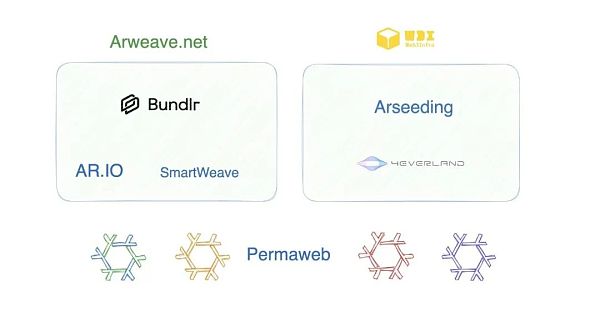
Image description: Arweave gateway types. Image source: Arweave SCP Ventures
4EVERLAND is also an important development infrastructure that provides one-stop web hosting services for applications and websites built on Arweave. Multiple domains, including Arscp.Ventures, use its services.
After setting up the node service, efficient index building tools are also needed. Developers need to retrieve data in a timely manner. Here, two projects are mainly introduced, namely KNN3 and Adot.
KNN3 and Arseeding have deep cooperation and can support real-time indexing services uploaded via Arseeding, and development work can be done through GraphQL.
Adot has built a full-text search service tool for the Arweave mainnet, allowing developers to retrieve any data uploaded to Arweave through Adot.
After building a complete storage, gateway (access), and index service tools, Arweave has become an always-on decentralized cloud service provider that can meet developers’ needs for all building and development services.
The last piece of the puzzle is how to onboard Web2 users. Currently, the consensus is abstract accounts, relying on traditional login methods such as email and phone numbers, and then building encrypted wallets and on-chain accounts. It is hoped that this approach can solve the problem of high entry barriers for Web2 users.
Two products are highlighted, namely EverID by everVision and the othent tool incubated by Community Labs, as well as its open-source Arweave Wallet Kit.
-
EverID builds a bridge between its login methods in Web2 and Web3 services using WebAuthn. EverID can use hardware devices (Windows, iOS, macOS, and Android) to generate identity keys locally and support sharding of private keys among multiple physical devices to improve security. After local identity generation, it can activate accounts and identities within the everLianGuaiy system without the need for users to record private keys or account addresses on the frontend.
-
Othent uses Google JWT (JSON Web Token) to register Google accounts on Arweave and calls Warp’s smart contract service to build an on-chain identity system.
Abstract accounts and wallet applications are different. Their goal is to lower the barrier for Web2 users to use blockchain, while the widespread use of Arweave also requires high-performance products, such as basic DeFi infrastructure and cross-chain bridges to other public chains.
Unlike pure storage services, complex DeFi and cross-chain bridges are very difficult to build on non-EVM public chains. However, once they can operate independently and stably, they will have a driving effect on the entire ecosystem.
LianGuairt VI: SCP Paradigm and Arweave Investment Matrix
For a long time, the Arweave ecosystem lacked the important infrastructure of a DEX. Most projects in the ecosystem could only choose to issue ERC-20 tokens to complete their token issuance.
Arweave itself proposed the PST (Profit Sharing Tokens) standard, but it can only run on Arweave and lacks the ability to cross-chain with larger market share public chains, thus unable to fully utilize market liquidity.
The everVision team proposed the SCP (Storage Consensus LianGuairadigm), which separates computation and storage, performing computation off-chain and storage on-chain.
Based on the SCP theory, the Arweave ecosystem DEX Permaswap was developed. It currently supports three formats of tokens: PST/ERC-20/everLianGuaiy native tokens. Furthermore, a universal payment protocol called everLianGuaiy has been developed, which already supports dozens of tokens from six public chains in the Arweave/EVM/Polkadot ecosystems.
Based on its own practice, everVision has collaborated with Asian digital banks to issue the offshore Chinese yuan stablecoin ACNH. It is completely based on everLianGuaiy for on-chain circulation, minting, redemption, and other operations. This is also everVision’s first attempt in the RWA field.
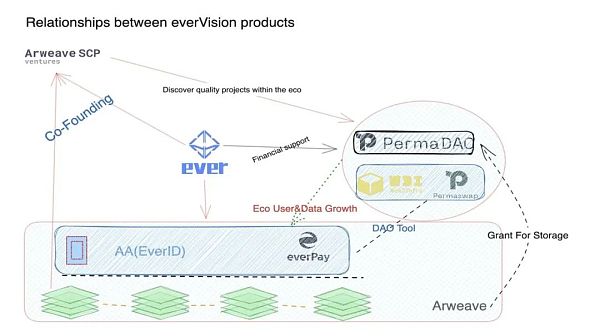
Image description: everVision product matrix, image source: Arweave SCP Ventures
In addition to regular product development, everVision’s leadership has established the Arweave ecosystem incubation and investment fund, Arweave SCP Ventures, to promote data growth on the Arweave network and incubation of related projects.
As of now, Arweave SCP Ventures has invested in several outstanding projects in various fields. The list is as follows:
-
ReadOn: A reading community built on the Read 2 Earn model, creating a value-circulating content community for global users;
-
Mind Network: A privacy service network built on ZK and FHE (Fully Homomorphic Encryption) technologies, ensuring data security for users;
-
4EVERLAND: Provides a one-stop website hosting service, enabling developers to spread their content in a decentralized manner, offering permanent storage and resistance to censorship;
-
Starpower: A startup project in the DePIN direction of intelligent sockets, aiming to bring environmental protection and Arweave into the daily lives of ordinary people, and contribute to global environmental improvement;
-
LegalNow: An AI lawyer and legal contract generation SaaS platform initiated by the founder of LegalDAO, aiming to democratize legal services;
-
S31 Labs: A content creator platform based on AI and symbiotic relationships, facilitating collaborative content editing and the use of various forms of materials.
The above projects cover multiple fields such as creator economy, DDB, website hosting and development tools, DePIN, and AI, expanding the reach of Arweave to various systems within Web3. In particular, the forward-looking layout in the DePIN field is expected to promote data growth on Arweave.
Overall, SCP theory has guided the practice of the everVision team and the establishment and growth of SCP Ventures, and in the future, this growth will reshape the current overall pattern.
LianGuairt VII: Conclusion
In 2023, Arweave celebrated its fifth anniversary, starting from the initial concept of permanent storage and gradually building a complete technical architecture, which can effectively store data for more than 200 years, standing out among the many storage projects.
Arweave has grown into the most decentralized storage infrastructure in the Web3 field, with the goal of building an eternal library for all of human civilization, storing all the achievements of human civilization to date.
Guided by this concept, Arweave has expanded from initial personal storage to enterprise-level storage, from static data to the DDB field, from a single storage service to data availability services, and from the experimental cooperation of Meta NFT to the wise choice of Lens, all of which prove the reliability of Arweave.
We will continue to update Blocking; if you have any questions or suggestions, please contact us!
Was this article helpful?
93 out of 132 found this helpful
Related articles
- Classification of Web3 Game Players Prototypes
- Does the future of MakerDAO belong to Cosmos rather than Solana?
- How will the sued founder of Tornado Cash fight against the Federal Reserve?
- Intention The starting point of Web3 interactive intelligence
- Will FTX liquidating $3.4 billion worth of crypto assets become the main culprit behind the market crash?
- Analyzing MEV on Friend.tech How is it executed? How is the profit made?
- SevenX Ventures Modular Smart Contract Account Architecture and Challenges





